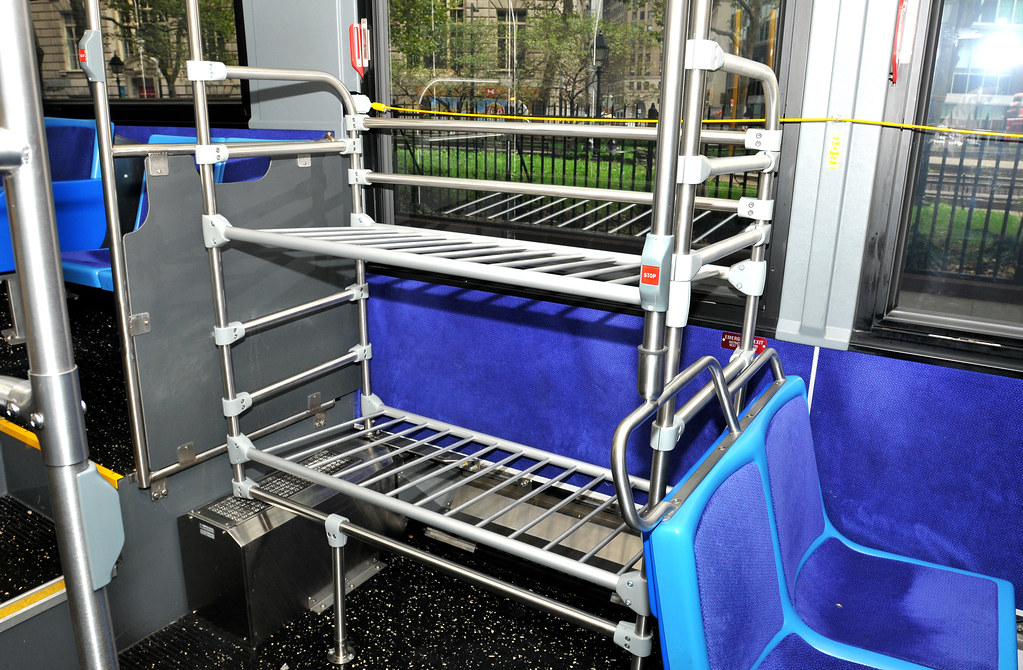
Imagine a Times Square unencumbered with cars. Imagine walking around 42nd St. in front of Grand Central without a steady stream of traffic passing by just inches from throngs of harried commuters. For years, that’s what Vision42 has desired.
Since Day One of Second Ave. Sagas, Vision42’s website has been on my blogroll, but I’ve never taken the time to explore the group’s initiative. With an article in The Times and an extensive post on The Transport Politic, today is definitely Vision42 day.
So we start with the organization’s mission statement. Vision42 is “a citizens’ initiative to re-imagine and upgrade surface transit in Midtown Manhattan, with a low-floor light rail line running river-to-river along 42nd Street within a landscaped pedestrian boulevard.” No longer would cars, trucks or buses of any kind be allowed on one of Manhattan’s most famous streets. Instead, sidewalks would be significantly widened and a fuel-cell powered light rail system would run from the 35 St. Ferry Terminal on the East Side, north toward the UN building and then along 42nd St. to the 39th St. Ferry Terminal on the West Side. The trams would stop at every avenue block from river to river.
According to the group’s report, a crosstown trip would take just 21 minutes, and trains would run every 3.5 minutes during peak times and every 4 minutes during off-peak hours. The trams would connect to every major north-south subway in Manhattan.
As far as its economic impact goes, the new tram would provide $700 million in economic benefits a year with an additional fiscal benefits in the form of property valuation increases of $175 million. Businesses along 42nd St. would see estimated economic increases of $430 million. (For more on the benefits of the project, check out page 30 of this pdf presentation.)
At the same time, Vision42 estimates that the full project would cost approximately $380-$580 million to install and could be ready to go in two years from the start date. Although utility relocation would be a concern, the group notes that heavy streetcars ran over utilities for decades with no problems. Utility relocation, though, remains the lion’s share of this project’s cost.
The article in today’s Times talks about the group’s make-up and the city’s unwillingness to support the project. Writes Alison Gregor:
While three large owners of real estate on 42nd Street and a real estate company that manages office buildings there have signed on to support the proposal, advocates for Vision 42 said they had not been able to engage the city in a discussion.
“We think the mayor considers this competitive with his No. 7 subway line extension,” said Roxanne Warren, an architect who is co-chairwoman of Vision 42.
Mayor Michael R. Bloomberg’s office said it was not inclined to support the proposal and deferred to the city’s Department of Transportation for comment. Scott Gastel, a spokesman for the department, said in an e-mail message, “While there are no plans for a project like this at this time, we are working closely with the M.T.A./N.Y.C. Transit to extend the 7 line, which will greatly improve commuter access throughout the corridor.”
The 7 line extension is a real estate-driven project whose wisdom has been questioned. It wouldn’t benefit people moving into and out of the 42nd St. businesses corridors and shouldn’t be equated with a proposal to radically reconceptualize an urban thoroughfare.
At TTP, Yonah Freemark talks about the costs of the project and who would foot the bill. He notes that the MTA won’t be paying for this project any time soon and urges the high-powered and deep-pocketed real estate ventures support the project to come forward with private investment. “Vision42 should be not working to change the Mayor’s mind,” he writes, “but rather to deliver a check to City Hall covering the line’s entire costs upfront. The administration might then find it easier to support the project.”
Drivers would protest the closure of this street, but in the end, the city would be better off for it. Unfortunately, both the political will and capital are lacking to push through a project of this scope. With it, though, you could truly meet those dances on the avenue streetcars are taking you to.






 The F line, much maligned and often overcrowded, is near and dear to my heart. I live nearby the stop at 7th Ave. in Brooklyn and often find myself relying on it for travel to and from home and parts of Brooklyn or Manhattan. A few years ago, securing
The F line, much maligned and often overcrowded, is near and dear to my heart. I live nearby the stop at 7th Ave. in Brooklyn and often find myself relying on it for travel to and from home and parts of Brooklyn or Manhattan. A few years ago, securing